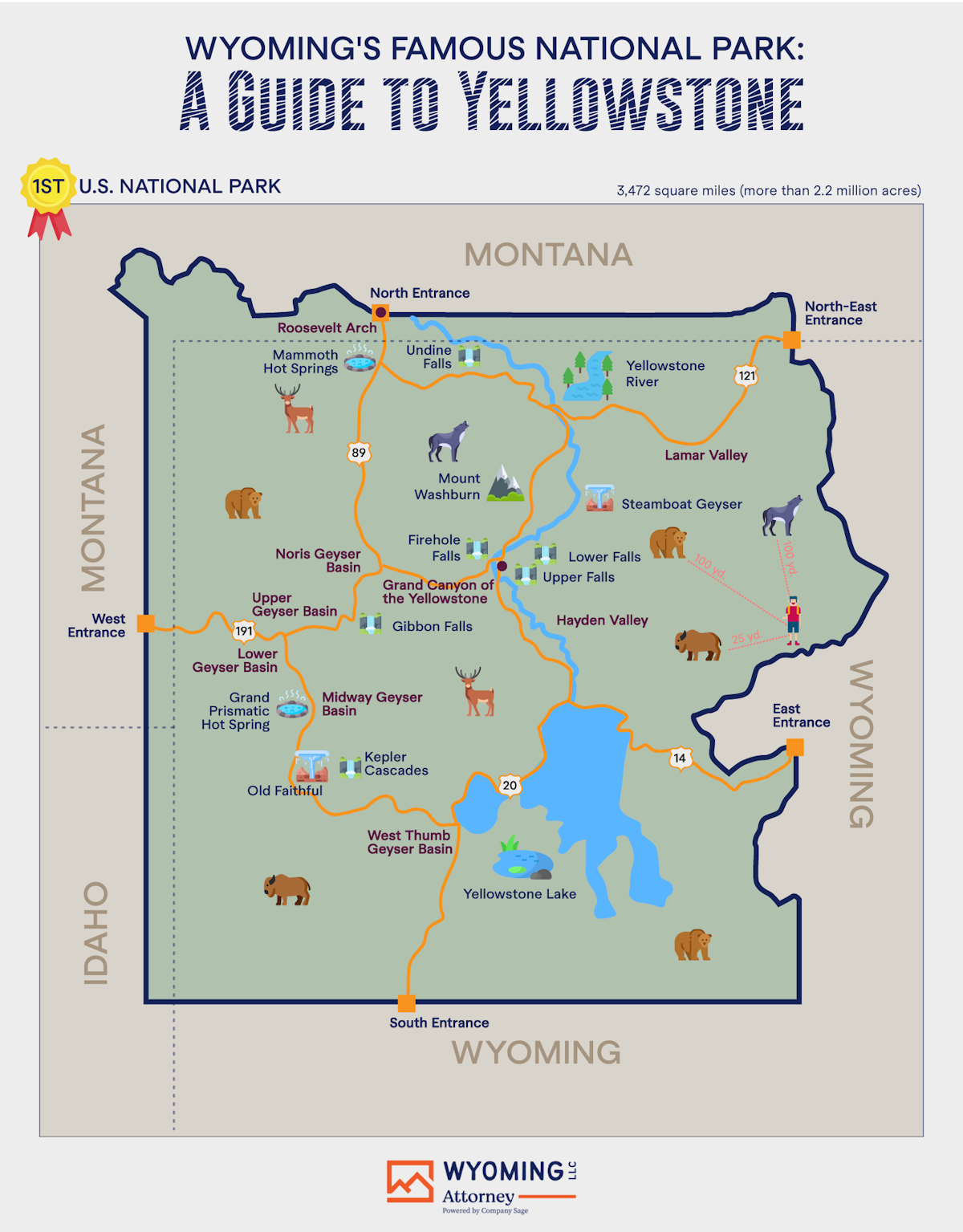- Wyoming's Famous National Park: A Guide to Yellowstone
Wyoming's Famous National Park: A Guide to Yellowstone
Yellowstone national park is located in the Western United States, with the vast majority of the park being in the state of Wyoming but a fraction of it does lie over in neighboring Montana and Idaho. The park is 3,472 square miles (over 2.2 million acres) which makes it larger than the states of Delaware and Rhode Island Combined. It was the first National Park in the USA and was established by the 42nd U.S Congress with the Yellowstone National Park Protection Act which was signed into law by President Ulysses S.Grant on the first of March in 1872.
Click the image to expand

Geography
Forests make up about 80% of Yellowstone, then rivers and lakes cover about 5% of the land area and most of the rest is grassland. The largest body of water is Yellowstone Lake which is 136 sq miles. Yellowstone contains 290 waterfalls of at least 15 feet with the highest being the Lower Falls of the Yellowstone River at 308 feet. There are three big canyons in the park; the Lewis Canyon, the Grand Canyon of the Yellowstone and the Black Canyon of the Yellowstone. The Grand Canyon of the Yellowstone was created by erosion from the Yellowstone river and it is more than 1000 feet deep, 1500-4000 feet wide and around 20 miles long. The elevation of Yellowstone is an average of 8,000 feet, ranging from 5,282 feet in the north, where the Gardner River drains from the park, to 11,358 feet in the east, at the summit of the Eagle Peak Mountain.
Geology
One of the world's biggest active volcanoes lies beneath Yellowstone and whilst it is still active, it has been around 70,000 years since the last lava flow. The first major eruption was 2.1 million years ago and covered more than 5,790 square miles with ash. The Park has many geysers. Geysers are a hot spring that shoots underground water into the air. Rainfall and melted snow soaks through the porous layers of rock until it eventually contacts the extremely high heat of the rocks deeper underground that have been heated by the magma. Pressure builds beneath the ground until eventually the boiling water deep in the ground pushes upwards enough to overflow which relieves the pressure on the water below which flashes into steam. This flash explodes through narrow gaps in the rocks and sends water shooting into the air. The Steamboat Geyser is in the park's Norris Geyser Basin and is the world's tallest currently active geyser. Steamboats' major eruptions normally last from between 3 minutes to 40 minutes and during these eruptions the water may be thrown more than 300 feet into the air. The schedule of the eruptions is hard to predict as it was dormant from 1911 to 1961 but in 2019 and 2020 there were 40 eruptions annually. The park also has several hot springs. These let off enough heat by surface evaporation so there is no steam explosion like with the geysers. The most notable hot spring is the Grand Prismatic which is the third largest spring in the world. It is larger than a football field at 370 feet in diameter.
Wildlife
The Yellowstone National park has more than 400 species of vertebrates which includes fish, reptiles, birds, amphibians, and mammals. The large diversity of the Yellowstone wildlife can be attributed to the diverse and wide ranging habitats that exist throughout the park.Yellowstone has the nation's largest remaining bison population on public land. Males can grow up to 2,000 pounds and can go up to 35 miles an hour. Whilst the number fluctuates there are some wolf-packs that live in Yellowstone and they have an average pack size of 10. This is due to a successful reintroduction of the gray wolf to the park in 1995 after wolf numbers dwindled and there were no remaining wolf packs. It is important to respect the animals in the park for their safety and visitor safety. Park rules state that you must stay at least 100 yards from bears and wolves and at least 25 yards from any other large animals that you encounter.
- The First National Park: Yellowstone
- Understanding Yellowstone's Dynamic Thermal System
- Hike a Trail - Yellowstone National Park
- The Ecosystem - Yellowstone Wildlife Sanctuary
- Yellowstone History
- AARP's Guide to Yellowstone National Park
- Yellowstone National Park : Climbing, Hiking & Mountaineering
- Hydrothermal Features - Yellowstone National Park
- Conservation Challenges of Yellowstone
- Webcams - Yellowstone National Park
- 7 Things You Didn't Know About Yellowstone National Park
- Yellowstone National Park Check List
- The Ultimate Guide to Yellowstone Wildlife Viewing
- Yellowstone River
- The Chemistry of Yellowstone's Hot Springs